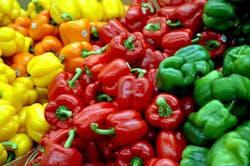There’s an impostor creeping around in horticultural lighting circles. And according to Fluence Bioengineering, this shadowy pretender is a force for good that could lead to greater yields and quality in crops such as tomatoes, cucumbers, strawberries, peppers, and lettuce, among others.
The masked intruder is none other than far-red light — light at the longest end of the red spectrum that is still visible to the human eye, albeit barely.
In a recent blog post, Austin, Texas–based Fluence points out that far red can trick plants into thinking they are in the shade, and thus encourage them to stretch toward areas of more light.
“As light penetrates a canopy, the plants at the top typically receive more white light, while plants on the ground or in the shade receive more far-red light,” notes blog author David Hawley, who is lead scientist at Fluence, a division of Signify. “This red/far-red shift triggers a complex response that tells plants to grow and stretch beyond the shade to receive more direct sunlight. Growers can use this understanding of far-red light to trick plants into growing and stretching as if they were in the shade.”
Take peppers, for example.
“Pepper is a slow-growing crop with blocky fruits,” Hawley notes of the vine crop. “These plants need sufficient space between the fruits as they develop. When crowding occurs, the fruits bump into each other and result in misshapen or bruised produce, which is bad for business. Far-red light induces vine stretch and provides more space for peppers to develop on the vine.”
While some pepper cultivars naturally stretch, “many legacy pepper crops need a percentage of FR to achieve optimal morphology,” Hawley adds.
Far red can be a great friend to strawberries too.
“Some strawberry cultivars are more prone to expansion than others, but in most cases a strawberry plant — whether Ever-Bearing or June-Bearing — is inherently compact,” Hawley writes. “A compact plant canopy retains water, which leads to unfavorably humid microclimates, slower productivity, and greater susceptibility to pathogens, molds, fungi, and other pests. Far-red light conclusively expands the strawberry canopy and improves airflow, which reduces the potential harms listed above while also improving insect pollination success and human workflow efficiency.”
In some strawberry varieties, FR does not induce stretch, but can increase the BRIX, which is a measurement of sweetness, he notes.
The lettuce business can benefit greatly because with lettuces, the entire above ground biomass is a product, unlike with vine crops which have non-harvestable vines, stems, and leaves.
“However, there is still a balance that growers must consider,” Hawley cautions. “If a lettuce plant receives copious amounts of far red, then it goes into hyperdrive and stretches faster than its biomass production can match. In doing so, the leaves become too thin, chlorotic (pale greenish yellow in color), soft, and wimpy. Their shelf life diminishes, and they lose value or become unmarketable. A proper balance queues the morphological response while driving photosynthesis hard enough to ensure that sugar production can keep up with the stretch.”
Hawley points out that while academic research at places including Holland’s Wageningen University & Research support the tricks of using far red, the commercial applications are not yet widespread.
“While FR is not recommended for every crop, the ability to influence plant growth, leaf size, stem length, and overall morphology has proven critical for commercial growers of vine crops — such as tomatoes, cucumbers, and peppers — as well as strawberries, lettuce, and more,” he says.
As LEDs Magazine reported earlier this year, Fluence parent Signify noted in a study with Wageningen, far red can indeed increase tomato yields, although it requires more energy than other spectra.
Signify has also tailored a fixed FR recipe for use with strawberries.
The FR discussion looks likely to continue. Not only is it food for thought in the horticultural trade, it is also thought for food.
MARK HALPER is a contributing editor for LEDs Magazine, and an energy, technology, and business journalist ([email protected]).
Follow our LinkedIn page for our latest news updates, contributed articles, and commentary, and our Facebook page for events announcements and more. You can also find us on the X platform.






